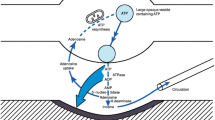Abstract
Interaction of ligands with ‘Ca2+-mobilizing’ receptors is thought to result in the generation of two second messengers, inositol trisphosphate and diacylglycerol, from a common substrate, phosphatidylinositol 4,5-bisphosphate (PtdIns(4,5)P2) (refs 1, 2), a component of plasma membranes3,4. It is not known how the occupation of such receptors is translated into the activation of the catalytic unit polyphosphoinositide (PPI) phosphodiesterase, and then to cellular activation, but our recent experiments suggest that GTP regulatory proteins may be involved. In mast cells, non-hydrolysable analogues of GTP introduced and then trapped in the cytosol are able to substitute for external ligands in inducing exocytosis, a well-defined Ca2+-dependent process5, suggesting that guanine nucleotide regulatory proteins may act by stimulating the catalytic activity of the PPI phosphodiesterase. We now provide evidence that mast cell secretion is inhibited by internalized neomycin, a compound known to interact with PPI6. We also show that the PPI phosphodiesterase of human neutrophil plasma membranes can be activated simply by adding GTP analogues in the presence of concentrations of Ca2+ that pertain in unstimulated cells. These findings strongly support the idea that the coupling factor linking receptor and PPI phosphodiesterase is a guanine nucleotide binding protein analogous to those involved in the activation and inhibition of adenylate cyclase7.
Similar content being viewed by others
References
Michell, R. H. Trends pharmac. Sci. 8, 263–265 (1983).
Berridge, M. J. Biochem. J. 220, 345–360 (1984).
Downes, P. & Michell, R. H. Cell Calcium 3, 467–502 (1982).
Cockcroft, S., Taylor, J. & Judah, J. D. Biochim. biophys. Acta (in the press).
Gomperts, B. D. Nature 306, 64–66 (1983).
Schacht, J. J. Lipid Res. 19, 1063–1067 (1978).
Rodbell, M. Nature 284, 17–22 (1980).
Bennett, J. P., Cockcroft, S. & Gomperts, B. D. J. Physiol., Lond. 317, 335–345 (1981).
Cockcroft, S., Baldwin, J. M. & Allan, D. Biochem. J. 221, 477–482 (1984).
Downes, C. P. & Michell, R. H. Biochem. J. 202, 53–58 (1982).
Downes, C. P., Mussat, M. C. & Michell, R. H. Biochem. J. 203, 169–177 (1982).
Remarks Concerning the Stability of GDP, GTP and dGTP (Boehringer Mannheim technical leaflet, 1984).
Anderson, Q. S. & Murphy, R. C. J. Chromat. 121, 251–262 (1976).
Cockcroft, S. Biochim. biophys. Acta 795, 37–46 (1984).
Hyslop, P. A. et al. FEBS Lett. 166, 165–169 (1984).
Houslay, M. D. Trends biochem. Sci. 9, 39–40 (1984).
Nakamura, T. & Ui, M. FEBS Lett. 173, 414–418 (1984).
Okajima, F. & Ui, M. J. biol. Chem. 259, 13863–13871 (1984).
Kaziro, Y. Biochim. biophys. Acta 505, 95–127 (1978).
Stryer, L. Cold Spring Harb. Symp. quant. Biol. 48, 841–852 (1983).
Heyworth, C. M., Rawal, S. & Houslay, M. D. FEBS Lett. 154, 87–91 (1983).
Heyworth, C. M., Wallace, A. V. & Houslay, M. D. Biochem. J. 214, 99–110 (1983).
McGrath, J. P., Capon, D. J., Goeddel, D. V. & Levinson, A. D. Nature 310, 644–649 (1984).
Newbold, R. Nature 310, 628–629 (1984).
Bennett, J. P., Caswell, A. H., Cockcroft, S. & Gomperts, B. D. Biochem. J. 208, 801–808 (1982).
Downes, C. P. & Michell, R. H. Biochem. J. 198, 133–140 (1981).
Author information
Authors and Affiliations
Rights and permissions
About this article
Cite this article
Cockcroft, S., Gomperts, B. Role of guanine nucleotide binding protein in the activation of polyphosphoinositide phosphodiesterase. Nature 314, 534–536 (1985). https://doi.org/10.1038/314534a0
Received:
Accepted:
Issue Date:
DOI: https://doi.org/10.1038/314534a0
- Springer Nature Limited
This article is cited by
-
Characterization of novel EST-SNP markers and their association analysis with growth-related traits in the Pacific oyster Crassostrea gigas
Aquaculture International (2017)
-
Impaired Feedback Regulation of the Receptor Activity and the Myofilament Ca2+ Sensitivity Contributes to Increased Vascular Reactiveness after Subarachnoid Hemorrhage
Journal of Cerebral Blood Flow & Metabolism (2010)
-
Nocardimicins G, H and I, Siderophores with Muscarinic M3 Receptor Binding Inhibitory Activity from Nocardia nova JCM 6044
The Journal of Antibiotics (2005)
-
Pertussis toxin and N-ethylmaleimide inhibit histamine- but not calcium ionophore-induced endothelium-dependent relaxation
Naunyn-Schmiedeberg's Archives of Pharmacology (2004)





